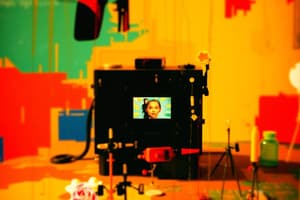Podcast
Questions and Answers
Who discovered silver nitrate?
Who discovered silver nitrate?
- Anthemius of Tralles
- Albertus Magnus (correct)
- Georg Fabricius
- Ibn al-Haytham
Who described a diaphragm?
Who described a diaphragm?
- Wilhelm Homberg
- Mo Di
- Tiphaigne de la Roche
- Daniele Barbaro (correct)
What was the primary concern in the early days of photography?
What was the primary concern in the early days of photography?
- Developing new photographic materials
- Inventing means to fix and retain the image (correct)
- Creating a pinhole camera
- Improving the camera obscura
Who wrote about a type of camera obscura in his experiments?
Who wrote about a type of camera obscura in his experiments?
Who discovered silver chloride?
Who discovered silver chloride?
What was the main limitation of Thomas Wedgwood's image reproduction method?
What was the main limitation of Thomas Wedgwood's image reproduction method?
What was the name of the device used by Renaissance painters to create an optical rendering in color?
What was the name of the device used by Renaissance painters to create an optical rendering in color?
Who produced the first permanent photoetching in 1822?
Who produced the first permanent photoetching in 1822?
What was the main goal of Nicéphore Niépce's and Louis Daguerre's partnership?
What was the main goal of Nicéphore Niépce's and Louis Daguerre's partnership?
What was the result of Louis Daguerre's redirection of experiments after Nicéphore Niépce's death?
What was the result of Louis Daguerre's redirection of experiments after Nicéphore Niépce's death?
Flashcards are hidden until you start studying
Study Notes
History of Photography
- Earliest known surviving heliographic engraving was made in 1825 by Joseph Nicéphore Niépce using his "heliographic process".
- Niépce took the first permanent photograph from nature using a camera obscura in 1826 or 1827, titled "View from the Window at Le Gras".
- The concept of a pinhole camera was described by Chinese philosopher Mo Di and Greek mathematicians Aristotle and Euclid in the 5th and 4th centuries BCE.
- Byzantine mathematician Anthemius of Tralles used a camera obscura in his experiments in the 6th century CE.
- Ibn al-Haytham (Alhazen) studied the camera obscura and pinhole camera (965-1040).
- Albertus Magnus discovered silver nitrate (1193-1280).
- Georg Fabricius discovered silver chloride (1516-1571).
- Daniele Barbaro described a diaphragm in 1566.
- Wilhelm Homberg described the photochemical effect in 1694.
- The book "Giphantie" (1760) by French author Tiphaigne de la Roche described what can be interpreted as photography.
Precursor Technologies
- The camera obscura was used by Renaissance painters to create optical renderings in color.
- Thomas Wedgwood obtained copies of paintings on leather using silver salts, but they would turn black in the light and had to be kept in a dark room for viewing.
- Leonardo da Vinci mentioned natural cameras obscura formed by dark caves on the edge of a sunlit valley.
First Camera Photography
- The first permanent photoetching was produced in 1822 by Nicéphore Niépce, but it was destroyed in a later attempt to make prints from it.
- Niépce's camera photographs required an extremely long exposure (at least eight hours and probably several days).
- Niépce and Louis Daguerre worked together to improve the bitumen process, leading to the discovery of a more practical and sensitive process.
- Daguerre continued to experiment with light-sensitive silver halides after Niépce's death in 1833, leading to the development of more practical and permanent photography.
Studying That Suits You
Use AI to generate personalized quizzes and flashcards to suit your learning preferences.




